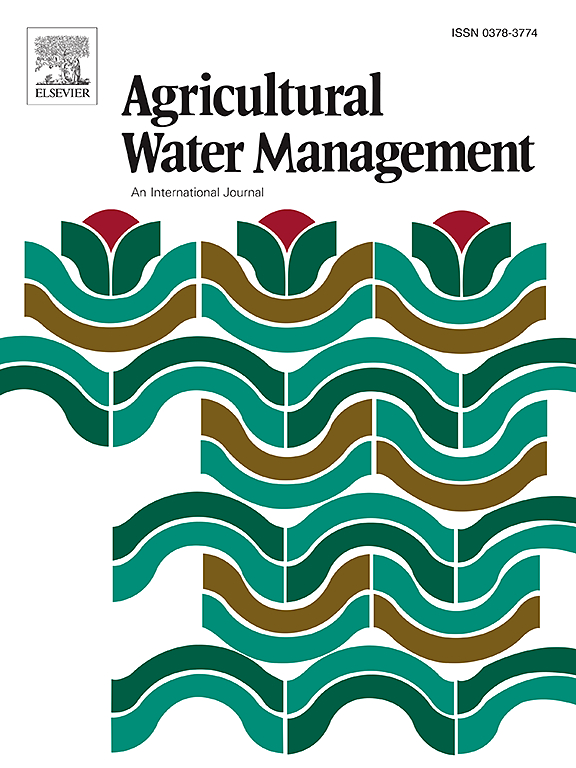Partial organic fertilizer replacing synthetic fertilizer reduces soil salinity, improves photosynthesis, and enhances the water-nitrogen use efficiency of maize (Zea maysl.) in arid regions
IF 5.9
1区 农林科学
Q1 AGRONOMY
引用次数: 0
Abstract
Soil salinization severely threatens agricultural sustainability in arid regions, compromising crop productivity and resource-use efficiency. While organic amendments show promise for mitigating salinity stress, the optimal organic-to-synthetic fertilizer ratio remains undetermined in saline-alkaline agroecosystems. A two-year field experiment was conducted on saline-alkaline soil in southern Xinjiang, China, to assess soil properties, maize photosynthetic characteristics, and water-nitrogen use efficiency. Seven treatments were tested: no N fertilization (CK); 100 % synthetic N fertilizer (SF); and organic fertilizer substituting 20 %, 40 %, 60 %, 80 %, and 100 % of the synthetic N (OF20 %, OF40 %, OF60 %, OF80 %, and OF100 %, respectively) with all fertilized treatments receiving 300 kg N ha−1. To identify the optimal ratio of chemical-to-organic fertilizer, a comprehensive evaluation model was employed for multi-objective optimization analysis. Results showed that soil salinity and nitrate-N residue in the 0![]() 100 cm soil layer decreased by 1.12 %
100 cm soil layer decreased by 1.12 %![]() 13.31 % and 14.06 %
13.31 % and 14.06 %![]() 51.48 %, respectively, with increasing organic fertilizer substitution ratio. Additionally, maize photosynthetic performance and growth parameters exhibited an initial increase followed by a decline as organic substitution increased, peaking at the 20 % organic fertilizer substitution treatment. Compared to the SF treatment, the OF20 % treatment increased yield by 2.95 %
51.48 %, respectively, with increasing organic fertilizer substitution ratio. Additionally, maize photosynthetic performance and growth parameters exhibited an initial increase followed by a decline as organic substitution increased, peaking at the 20 % organic fertilizer substitution treatment. Compared to the SF treatment, the OF20 % treatment increased yield by 2.95 %![]() 8.03 %, crop water productivity by 2.98 %
8.03 %, crop water productivity by 2.98 %![]() 7.83 %, and nitrogen use efficiency by 1.85 %
7.83 %, and nitrogen use efficiency by 1.85 %![]() 46.19 %. Regression analysis based on a multi-objective comprehensive evaluation model determined the optimal organic fertilizer substitution ratio to be 21.32 %. This enhancement resulted from improved soil physiochemical properties, enhanced photosynthetic capacity, and optimized resource utilization. These findings demonstrate that strategic partial organic substitution represents an effective strategy for sustainable intensification in salt-affected agricultural systems worldwide.
46.19 %. Regression analysis based on a multi-objective comprehensive evaluation model determined the optimal organic fertilizer substitution ratio to be 21.32 %. This enhancement resulted from improved soil physiochemical properties, enhanced photosynthetic capacity, and optimized resource utilization. These findings demonstrate that strategic partial organic substitution represents an effective strategy for sustainable intensification in salt-affected agricultural systems worldwide.
在干旱区,部分有机肥替代合成肥可降低土壤盐分,促进光合作用,提高玉米水氮利用效率
土壤盐渍化严重威胁干旱地区农业的可持续性,影响作物生产力和资源利用效率。虽然有机改良剂有望缓解盐胁迫,但在盐碱农业生态系统中,有机与合成肥料的最佳比例仍未确定。在新疆南部盐碱土壤上进行了为期2年的田间试验,研究了土壤性质、玉米光合特性和水氮利用效率。试验7个处理:不施氮(CK);100% %合成氮肥;和有机肥料替代20 % 40 % 60 %,80 %,100 %的合成N (OF20 %,OF40 %,OF60 %,OF80 %,和金 %,分别)与受精治疗收到300 公斤 N ha−1。为了确定有机肥与化肥的最佳配比,采用综合评价模型进行多目标优化分析。结果表明:随着有机肥替代比的增加,0100 cm土层土壤盐分和硝态氮残留量分别降低1.12 %、13.31 %和14.06 %、51.48 %;此外,随着有机替代的增加,玉米的光合性能和生长参数呈现先上升后下降的趋势,在20% %有机肥替代处理时达到峰值。与顺丰处理相比,OF20 %处理产量提高2.95 %8.03 %,水分生产力提高2.98 %7.83 %,氮素利用效率提高1.85 %46.19 %。基于多目标综合评价模型的回归分析确定了最优有机肥替代率为21.32 %。这种增强是土壤理化性质改善、光合能力增强和资源利用优化的结果。这些发现表明,战略性部分有机替代是全球受盐影响农业系统可持续集约化的有效策略。
本文章由计算机程序翻译,如有差异,请以英文原文为准。
求助全文
约1分钟内获得全文
求助全文
来源期刊

Agricultural Water Management
农林科学-农艺学
CiteScore
12.10
自引率
14.90%
发文量
648
审稿时长
4.9 months
期刊介绍:
Agricultural Water Management publishes papers of international significance relating to the science, economics, and policy of agricultural water management. In all cases, manuscripts must address implications and provide insight regarding agricultural water management.
 求助内容:
求助内容: 应助结果提醒方式:
应助结果提醒方式:


